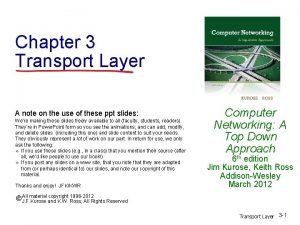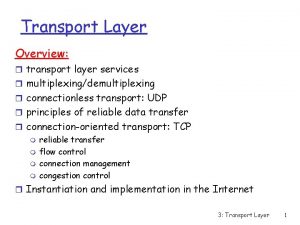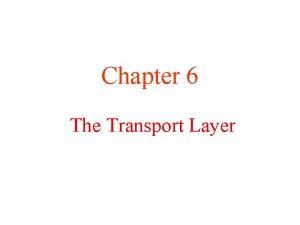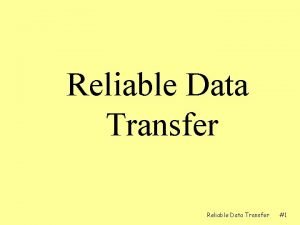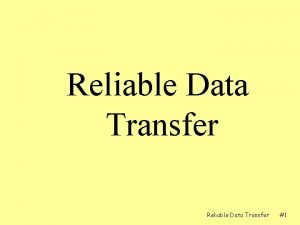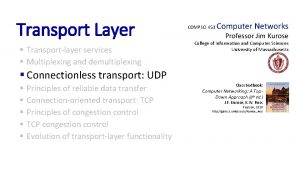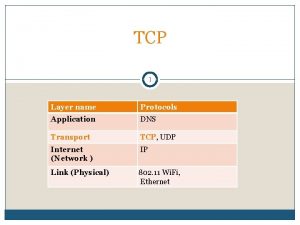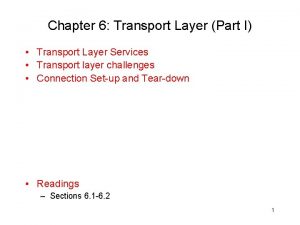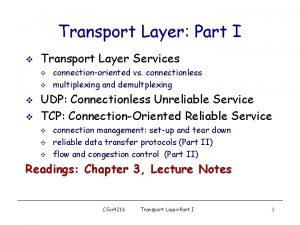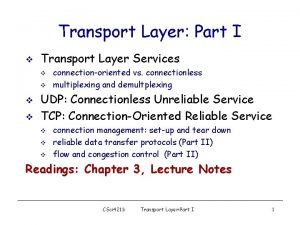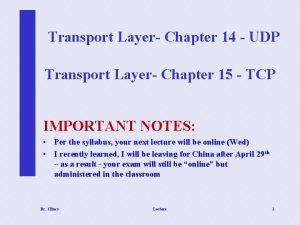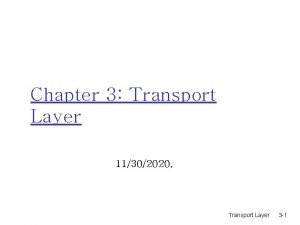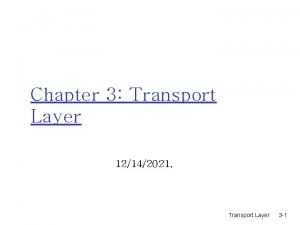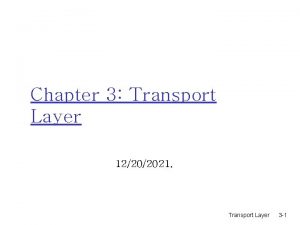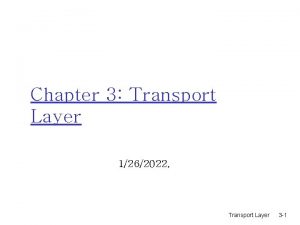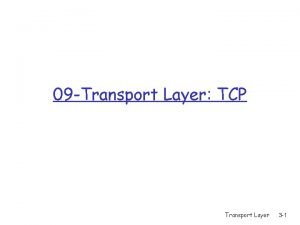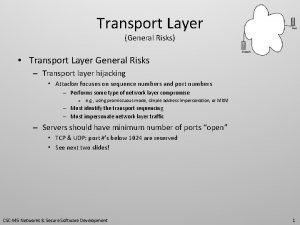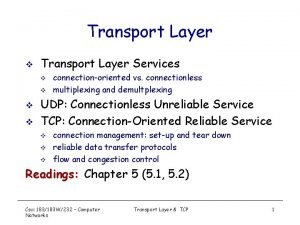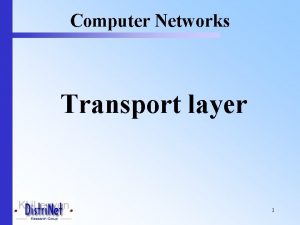Chapter 6 Transport Layer Part I Transport Layer






















- Slides: 22

Chapter 6: Transport Layer (Part I) • Transport Layer Services • Transport layer challenges • Connection Set-up and Tear-down • Readings – Sections 6. 1 -6. 2 1

Transport Layer • Provides transport services to applications • End-host to end-host delivery of data • Aspects of transport services – Error detection and recovery • Errors (lost or corrupted data) detected at receiver? • Detected error corrected? – Framing • Data unit boundaries (e. g. , message) preserved? – Timing • Timing between data preserved when delivered at receiver? 2

Common Transport Service Models • Connectionless datagram – No promises, no timing – Error detection optional, no error recovery • Connection-oriented reliable – Error recovery, no timing • Circuit-like – Timing preserved – No error recovery, optional error detection 3

Connection Paradigms • Connection-oriented – – Explicitly setup/tear down connections Setup connection context (“connection state”) Initial sequence number, flow control window size Exchange data within context of connection • Connectionless service – Pure datagram • One-time unreliable send – Transaction oriented • Single request from sender, single reply from receiver 4

Transportation Layer. vs. data link layer • Very similar – two hosts connected by a link or two hosts connected by a network – Build reliable services over underlying unreliable communication • differences: – When two hosts are connected by a link, packets will not reorder or duplicate (if the sender sends only once). In addition, packets will either get to the receiver or get lost. – When two hosts are connected by a network, packets can be duplicated, delayed, lost, reordered. – Implication: The problems to be addressed in the transport layer are very similar to those in the data link layer. However, the solutions may be more complex.

Problems • The problem is that network can delay, reorder, lose packets – Time-out/retransmission introduces duplicates of data, acknowledgement, connect, close packets • Worst case scenario: consider this bank transaction example – – (a) setup connection (b) transfer $100 (c) close connection all messages are delayed and replayed.

Other challenges • Transport layer protocol: varying data rate and varying packet delay – Need to adapt to the data rate and delay rate – Sliding window alone would not be sufficient – Network congestion control issue • Flow control: fast sender and slow receiver • Congestion control: global network problem, each flow may be ok, but the sum of all flows is too much for the network to handle. • Congestion control is harder than flow control • Because of these, transport layer protocols are more difficult to design than data link layer protocols. 7

End-to-End Issues (for connection-oriented) • How to build a reliable, in-order delivery? – On top of an unreliable network layer service • Potentially connects different hosts – Need explicit connection establishment and termination • Potentially different RTT (round-trip time) – Need adaptive timeout mechanisms • Potentially long delay in network – Need to be prepared for arrival of very old packets – Connection management 8

End to End Issues for connection-oriented • Potentially unreliable network service – Need to be prepared for • corrupted/lost and out-of-order packets – Error control • Potentially different capacity at destination – Need to avoid overrunning receivers – flow control • Potentially different network capacity – Need to be prepared for network congestion – Congestion control 9

Connection Management Issues • How to identify a connection between end hosts? – Source/destination IP addresses + port numbers – Is it sufficient? • What about different incarnations? • Potential problems – Network can delay, reorder, lose packets – Time-out/retransmission introduces duplicates of • Data, acknowledgement, connect, close packets 10

Connection Management Issues • On packet arrival: is it real or not? – New connection request/release or an old one? – Transport protocols must create/maintain/destroy • Enough state to answer the memorex question • Major issues – How to choose an identifier for each packet • So that no other packets currently in the network – Associated with this host have the same identifier – How to deal with old or duplicate (connect) messages • Delayed duplicate problem 11

Choosing Unique Identifier • Choose an identifier (or sequence number) to – Distinguish any two outstanding packets/connections • associated with a host – Connection identified by • <host id. , port no. > pairs plus a “unique” initial seq number • Host id unique globally, why not sufficient to use – <host id. , port no. > pairs to identify connections? • Time stamp each pkt using a time-of-day clock? • Solution: Assume maximum lifetime (T) for a pkt – Network layer kills packets when they reach max lifetime 12

Choosing Unique Identifier • Approach 1: maintain state – Keep list of all values used in last 2 T (why 2 T? ) • Don’t reuse value in list • If list lost: wait 2 T – Concerns? • Too much connection state • Too long waiting time • Approach 2: – Choose at random from large set (e. g. 232) of numbers • Unlikely to choose new number previously chosen in last 2 T • Can be combined with used value list for more protection – Good enough for many people 13

Connection Setup • Exchange control messages between two end hosts – To setup (or reject) connection before sending data • Issues to be considered – How to handle lost messages • Use timer and retransmission – How to identify and handle old/duplicate messages • Keep some state info (e. g. seq. no. of packets sent etc) • Two basic approaches – Two-way handshake (with timers) – Three-way handshake 14

Three-Way Handshake • Connection initiator (the client) – Chooses unique seqno x and sends req-conn(x) • Connection respondent (the server) – Upon receiving req-conn(x) • Chooses its own unique identifier, y • Sends ack-conn(y, x) • Upon receiving ack-conn(y, x), client responds – With ack-conn(x+1, y) • Why does server need to choose unique seqno y? 15

Three-Way Handshake 16

Three-way handshake (cont’d) Old message server client req-con n(x) ignored ) x , y ( onn Connection Not established ack-c 17

Connection Setup: Summary • How to deal with old and duplicate messages? – Receiver also chooses its own unique identifier y • Requires sender to reply back using y • Allows receiver to detect old sender messages without timers 18

Closing a Connection • Reaching agreement: two approaches – Abort: send close msg to peer, delete state info • What if close() message lost? – Graceful: send close msg, but before deleting state • Wait for peer to acknowledge close() • Problem solved? – Can I decide to close, knowing that • Other entity also agreed to close and knows that I will close • Can two armies coordinate their attacks – If communication is unreliable? 19

Two-Army Problem 20

Connection Release 6 -14, a, b Four protocol scenarios for releasing a connection. (a) Normal case of a three-way handshake. (b) final ACK lost. 21

Connection Release 6 -14, c, d (c) Response lost. (d) Response lost and subsequent DRs lost. 22
 Secure socket layer and transport layer security
Secure socket layer and transport layer security Secure socket layer and transport layer security
Secure socket layer and transport layer security Secure socket layer and transport layer security
Secure socket layer and transport layer security Secure socket layer and transport layer security
Secure socket layer and transport layer security Chapter 3 transport layer
Chapter 3 transport layer Pigmented layer and neural layer
Pigmented layer and neural layer Parietal layer and visceral layer
Parietal layer and visceral layer Layer 6 presentation layer
Layer 6 presentation layer Layer 2 e layer 3
Layer 2 e layer 3 Layer-by-layer assembly
Layer-by-layer assembly Layer 2 vs layer 3 bitstream
Layer 2 vs layer 3 bitstream Transport layer handles multiplexing and demultiplexing
Transport layer handles multiplexing and demultiplexing Layer 2 transport
Layer 2 transport Principles of reliable data transfer in transport layer
Principles of reliable data transfer in transport layer Crash recovery in transport layer geeksforgeeks
Crash recovery in transport layer geeksforgeeks Transport service primitives
Transport service primitives Wireless transport layer security
Wireless transport layer security Tcp reliable data transfer
Tcp reliable data transfer Reliable data transfer
Reliable data transfer Multiplexing and demultiplexing in transport layer
Multiplexing and demultiplexing in transport layer Dns transport layer protocol
Dns transport layer protocol Transport layer
Transport layer Mobile transport layer
Mobile transport layer




